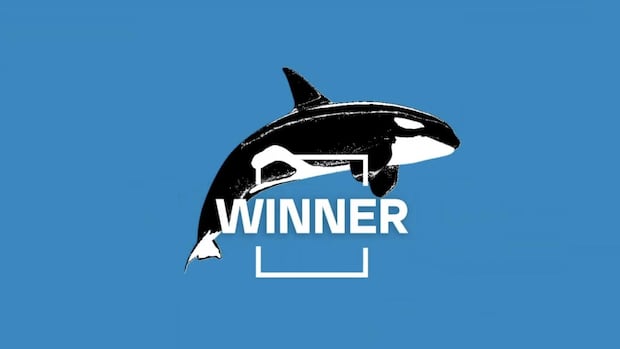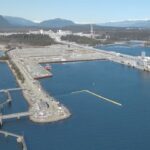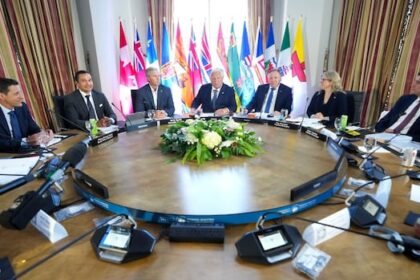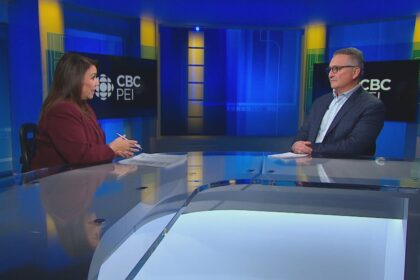British ColumbiaThe winner comes after five weks, 500,000 votes, and a semifinal win against B.C.’s official tree, a quarterfinal win against the official mammal, and a round of 16 victory over the official bird.After five weeks and 500,000 votes, it’s the winner of our highly scientific competition over 63 other symbolsJustin McElroy · CBC News · Posted: Aug 15, 2025 12:39 AM EDT | Last Updated: August 15Orca wins The Search for British Columbia’s Best SymbolAfter five weeks and around 500,000 votes, British Columbians have selected the orca over 63 other symbols in our summer competition to find which of them represents our province best. Justin McElroy explains why it won. Correction: An earlier version of this video incorrectly said that Lauren Laturnus, a biological science masters student, doesn’t see orcas at Saturna Island. The video has been updated to reflect that southern resident killer whales were seen once there in July. Bigg’s killer whales are commonly seen there.It’s black, white, and the best symbol of British Columbia.The orca has emerged victorious in The Search for B.C.’s Best Symbol, defeating 63 other challengers in a friendly summer-long competition by CBC News to determine what iconic thing in this province best represents us. After five weeks and 500,000 votes, the orca defeated the totem pole in the final by a comfortable 64-36 per cent margin to win the unofficial and unscientific crown.It came after a semifinal win against B.C.’s official tree (the Western Red Cedar), a quarterfinal win against the official mammal (the spirit bear), and a round of 16 victory over the official bird (the Steller’s jay).”They’re an indicator of the health of the entire province,” said Lauren Laturnus, a biological sciences masters student who has spent her last four summers on Saturna Island monitoring the whales as they pass through the Salish Sea.”It reflects the interconnectedness of the entire province and they rely on the salmon from B.C.’s rivers and streams, which then rely on the forests.”In other words, the orca — strong, beautiful, communal and connected to nature — fully earned its title as the province’s best symbol. How orcas became such a big symbol of British ColumbiaThey were once seen by many as threatening monsters, but today are beloved. How did the perception of orcas change so much? Justin McElroy reports.From ‘something to be feared’ to B.C.’s best symbolIt’s indicative of a remarkable turn in public opinion in B.C. towards orcas, an apex predator that is typically highly social and has deep family bonds. While to the Nuu-chah-nulth First Nations, orcas are the guardians of the sea, and for the Tsleil-Waututh people, the whales are a source of spiritual power and teachings, to many settlers they were seen as competitors for B.C.’s salmon population. The whales were labelled “criminals” in newspaper headlines, and there was even talk of using machine guns to hunt them down. “They were seen as an animal that was quite terrifying and something to be feared,” said Andrew Trites, director of the University of B.C.’s Marine Mammal Research Unit.”Even the name they were given, killer whales, that should be a red flag right there,” he said.But after many orcas were put in captivity in the 1960s — including the famous Moby Doll, captured off the coast of Saturna and placed in the Vancouver Aquarium — public perception swiftly changed.”The public as well as scientists started to think about orcas not just as indistinguishable black and white predators with scary-looking teeth … but actually as individuals with their own personalities, their own connections to other whales and even potentially to us,” said Jason Colby, a University of Victoria historian and author of Orca: How We Came to Know and Love the Ocean’s Greatest Predator.Southern B.C. orca numbers droppingB.C.’s love of orcas has led to them becoming the mascot for the Vancouver Canucks (Fin) and the 1994 Victoria Commonwealth Games (Klee Wyck). They’re also available for purchase as stuffed animals or paintings in shops across the province.But the love has also led to an environmental movement to fight for their survival.While many transient and northern resident orcas spend much of their time in B.C. waterways, the group arguably most associated with B.C. — the southern resident orcas — number just 73 left. Pollution of the waterways and decreases in the salmon population have been blamed as culprits, and in recent decades several orcas have died just months after being born. This year, Laturnus says the southern residents haven’t been spotted at Saturna Island as often as previous years — only once in July.”It is a bit worrying because this is their traditional habitat and their summer foraging home,” she said.A contested connection to our environment is part of the B.C. story. But so too is beauty and grace, social and family bonds, and a love of oceans and fish.And all of that, tied up in one animal, makes for a pretty good symbol. CorrectionsAn earlier version of this story incorrectly said the southern resident killer whales had not made it to Saturna Island this year. In fact, Lauren Laturnus, a biological science masters student, says they were seen there once in July.Aug 15, 2025 3:16 PM EDTABOUT THE AUTHORJustin is the Municipal Affairs Reporter for CBC Vancouver, covering local political stories throughout British Columbia.
The Orca crowned winner of The Search for B.C.’s Best Symbol











